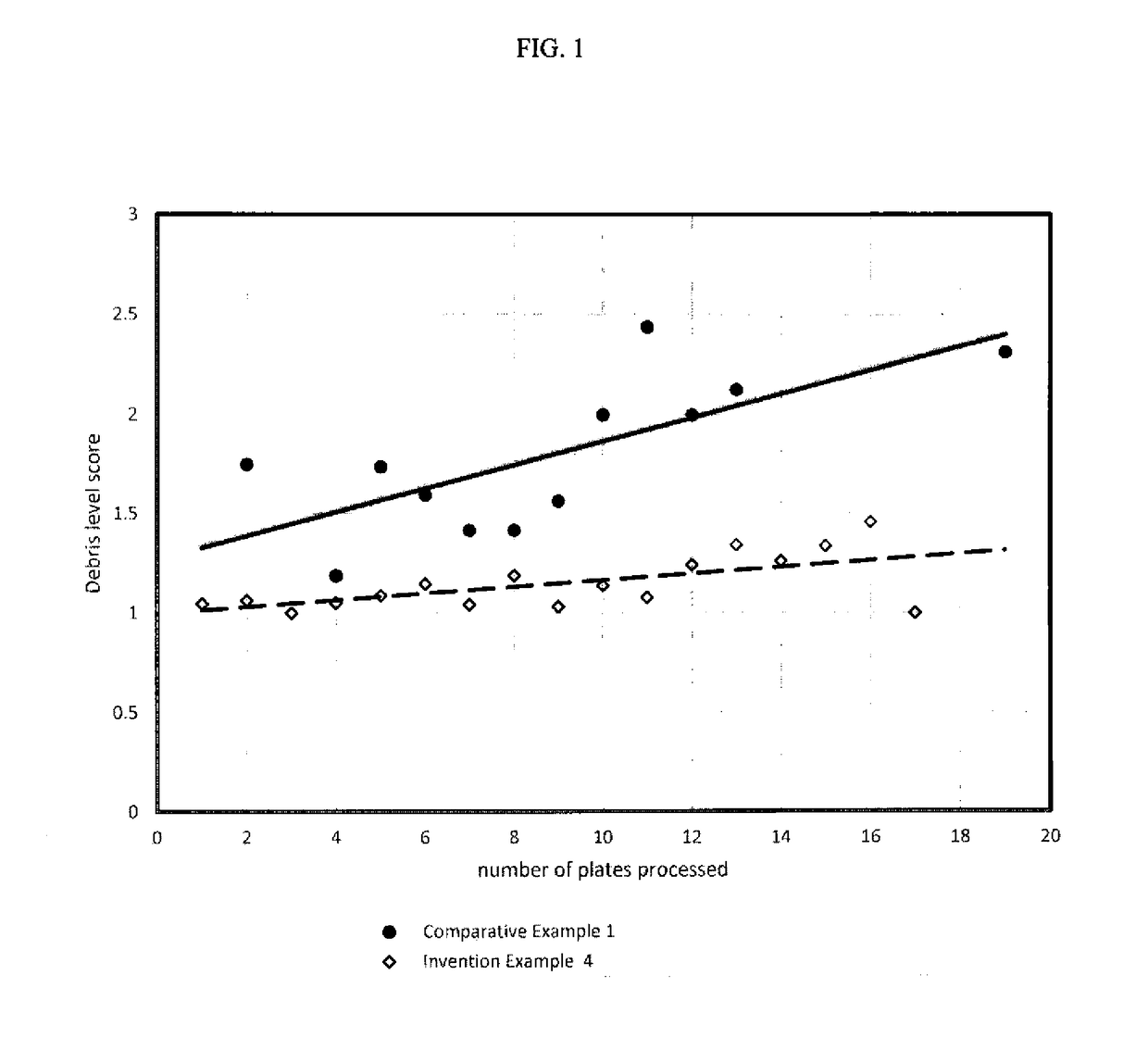Concentrated and working strength aqueous flexographic developers
a technology of aqueous flexographic and concentrates, which is applied in the direction of microlithography exposure apparatus, instruments, photomechanical treatment, etc., can solve the problems of difficult to achieve, frequent change of processing solutions, image deterioration, etc., and achieves less toxic or hazardous, stable composition ph, and reduced viscosity
- Summary
- Abstract
- Description
- Claims
- Application Information
AI Technical Summary
Benefits of technology
Problems solved by technology
Method used
Image
Examples
invention example 1
[0138]A flexographic developer concentrate was prepared according to the present invention by allowing a fatty acid mixture to react with potassium hydroxide. The pH was adjusted to 10.6 and water was added to bring the solids concentration to 21 weight %. The final flexographic developer concentrate had the following components and amounts:
Palmitic acid0.04%Steric acid0.46%Oleic acid15.77%Linoleic acid1.24%Linolenic acid0.02%Potassium hydroxide3.48%Water79.00%
[0139]One part of this concentrate was diluted with 42 parts of water to provide an aqueous flexographic developer having a total fatty acid and fatty acid salt concentration of 0.5 weight % and a pH of 10.5. The resulting aqueous flexographic developer was placed in an orbital processor unit and used to process exposed flexographic printing plates as described above in Comparative Example 1, using known conditions and procedures for such flexographic printing member precursors. The amount of debris on the processed flexograph...
invention example 2
[0140]A flexographic developer concentrate was prepared according to the present invention by allowing a fatty acid mixture to react with potassium hydroxide. Potassium carbonate was added and the pH was adjusted to 10.6. Water was added to bring the solids concentration to 21 weight %. The final flexographic developer concentrate had the following components and amounts:
Palmitic acid0.03%Steric acid0.33%Oleic acid11.19%Linoleic acid0.88%Linolenic acid0.01%Potassium hydroxide2.47%Potassium carbonate6.09%Water79.00%
[0141]One part of the resulting flexographic developer concentrate was diluted with 42 parts of water to provide an aqueous flexographic developer having a total fatty acid and fatty acid salt amount of 0.5 weight % and a pH of 10.5.
[0142]This aqueous flexographic developer was placed in an orbital processor unit and used to process exposed flexographic printing plates as described above in Comparative Example 1, using known conditions and procedures for such flexographic ...
invention example 3
[0143]A flexographic developer concentrate was prepared according to the present invention by allowing a fatty acid mixture to react with potassium hydroxide. Potassium carbonate and EDTA disodium salt were added and the pH was adjusted to 10.6. Water was added to bring the solids concentration to 21 weight %. The final flexographic developer concentrate had the following components and amounts:
Palmitic acid0.02%Steric acid0.29%Oleic acid10.00%Linoleic acid0.79%Linolenic acid0.01%Potassium hydroxide2.21%Potassium carbonate5.44%EDTA disodium salt2.25%Water79.00%
[0144]One part of the resulting flexographic developer concentrate was diluted with 42 parts of water to provide an aqueous flexographic developer having a total fatty acids and fatty acid salts content of 0.5 weight % and a pH of 10.5.
[0145]The aqueous flexographic developer was placed in an orbital processor unit and used to process exposed flexographic printing plates as described above in Comparative Example 1, using known...
PUM
| Property | Measurement | Unit |
|---|---|---|
| weight % | aaaaa | aaaaa |
| weight % | aaaaa | aaaaa |
| weight % | aaaaa | aaaaa |
Abstract
Description
Claims
Application Information
 Login to View More
Login to View More - R&D
- Intellectual Property
- Life Sciences
- Materials
- Tech Scout
- Unparalleled Data Quality
- Higher Quality Content
- 60% Fewer Hallucinations
Browse by: Latest US Patents, China's latest patents, Technical Efficacy Thesaurus, Application Domain, Technology Topic, Popular Technical Reports.
© 2025 PatSnap. All rights reserved.Legal|Privacy policy|Modern Slavery Act Transparency Statement|Sitemap|About US| Contact US: help@patsnap.com

